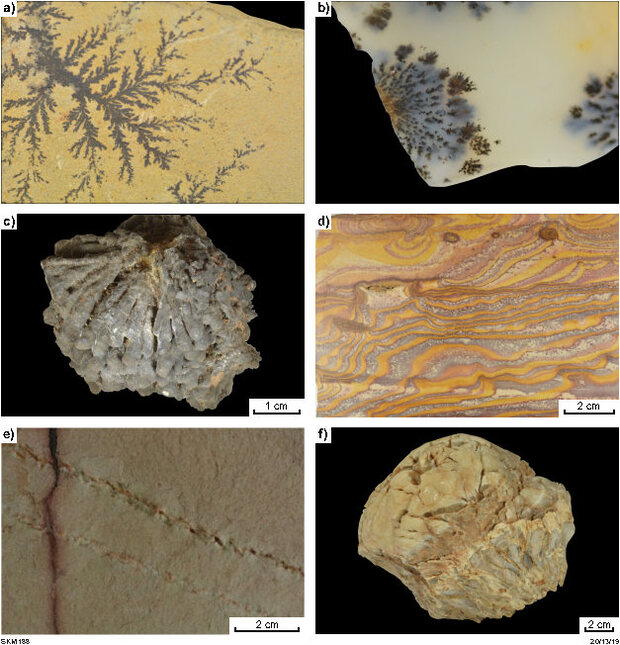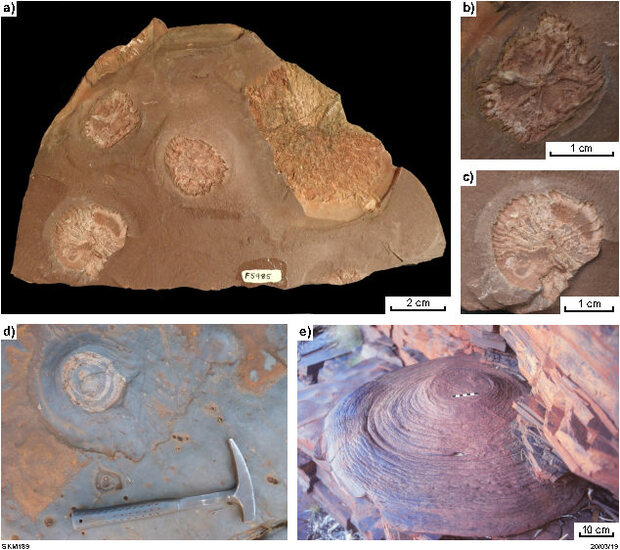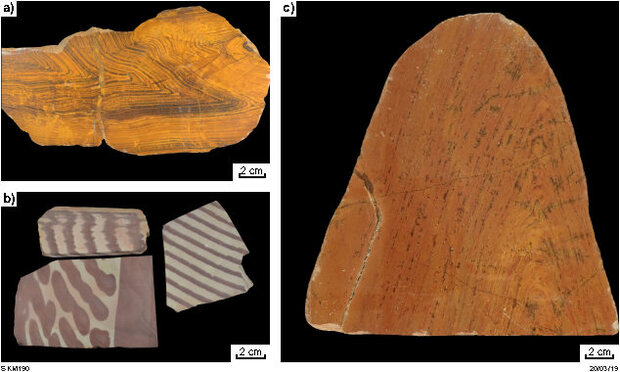Have you ever found a rock in the shape of a love heart? Or shaped like Australia? What about one that looks like a flower or a shell? Or seen a shape in a flat rock surface that looks just like a human footprint? The forces of wind, water, and time constantly work to shape rocks into a range of shapes, sizes and colours — including ones that look like past life. Scientists call these features pseudofossils. Pseudofossils are formed by inorganic (non-living) processes but look like fossils or other signs of life.
How do geologists decide what is a fossil?
Geologists, particularly paleontologists, are trained to identify whether or not a rock feature represents a real fossil. They make detailed observations of the rock feature and then compare these features to living organisms and known fossils. Many scientific tools, like microscopes, thin sections, and CRT and synchrotron scans, can be used to help observation.
Chemical tests can also help determine if a feature is a fossil, as the decay of biological material creates a number of specific chemicals, called biomarkers. Finding a biomarker can tell you whether the feature you are seeing was formed by life, and can often tell you what sort of life — such as plant, vertebrate or crustacean — made the fossil as well. However, biomarkers aren’t always preserved in rocks, as weathering and oxidation can remove them, leaving only the observed shape to work with.
In some cases, it can be very hard to decide if a rock feature represents past life. This is true when the geological processes that have influenced a rock are extreme, removing most of the evidence that would identify whether or not a feature is biogenic. This is also true for the very earliest forms of life, which can look very different from what we recognise as life today.
Common types of pseudofossils
In addition to rocks sculpted by normal weathering processes into plant-like or animal-like shapes, there are some types of rocks or rock features that are commonly mistaken for fossils.

Concretions and nodules
Both concretions and nodules are formed by the movement of water and chemicals through a body of sediment, normally before it has been fully cemented or solidified into a rock. A speck or crystal may focus these chemicals so they come out of solution and harden around a core before other parts of the sediment are hardened, in this way forming a nodule. These precipitations build up slowly during time, eventually forming the mineral masses that are concretions or nodules. These masses can in time even fuse together later to form larger masses.
Colour changes and banding in these features can be due to subtle changes in the mineral chemistry during time or changes in oxygen levels or oxidation state. A good example of this can be seen in iron-oxide minerals. Hematite is red-brown and often formed in oxygen-rich environments, while magnetite is black-brown and forms in oxygen-poor conditions, and goethite is yellow-brown and tends to form in wetter conditions.
Concretions are features in which minerals precipitate and form in layers around a central nucleus. This nucleus can be a speck of mineral such as pyrite, or an organic item such as a shell or leaf. As such, cracking open a concretion can sometimes reveal a fossil at the centre, even if the concretion itself is not a fossil. If split open, concretions tend to be round externally and are often heavily layered internally. Due to their round shape, concretions can be mistaken for eggs, marbles or bowling balls. One particular type, called a septarian concretion or septarian nodule, contains numerous angular cracks that form a network, usually in a contrasting colour. These concretions are regularly mistaken for fossil turtle shells. Pea gravel, which is common throughout Western Australia, is a type of concretion.
Nodules fill spaces within the sediment, rather than form around a single point. As a result, they tend to be irregularly shaped with little internal structure. Nodules can still form around fossils, but this process is less common.
A wide range of minerals contribute to the formation of concretions and nodules, including silica minerals (chert, jasper, agate and flint), calcium minerals (calcite, dolomite and ankerite), iron-rich minerals (pyrite, siderite, marcasite, hematite and goethite), phosphate minerals (apatite), and sulfates (barite and gypsum).
Some of the features colloquially known as ‘thunder eggs’ are nodules or concretions. In this case, the centre of the nodule or concretion has undergone later dissolution, creating a void later filled with mineral growths or loose sand. These ‘thunder eggs’ are somewhere between a concretion and a geode. Thunder eggs, in the original lapidary sense, are agate geodes formed in volcanic settings and not a concretion at all.
Cone-in-cone structures and shatter cones
Both cone-in-cone structures and shatter cones are interesting features that look like stacks of up-ended cones arranged side by side in cross-section. These strange geological features are regularly mistaken for stromatolites, horn corals, or pointed fossils, like teeth.
Cone-in-cone structures
Cone-in-cone structures are found only in sedimentary rocks. The cones tend to be small (millimetre to decimetre scale), form perpendicular to bedding, are generally textured by ridges or grooves along the side, and are nested, with the central part of the cone often detaching intact. Although the mechanisms that form these cones are still under investigation, they appear to be formed by fibrous minerals such as gypsum or calcite. Pressures, whether from the environment or due to additional mineral growth or conversion from one mineral form to another (such as aragonite to calcite), appear to force the minerals to buckle and fold into cone-shapes. The ridges seen on the structures are formed by fibres within the cones.
Shatter cones and conical fractures
Shatter cones are conical fractures generally interpreted as shock features related to impacts. Their form is variable, appearing as individual cones or as sets of overlapping features. Like cone-in-cone structures, these features often have ridges or grooves along the side of the feature, but the cones are not nested, and cannot be detached. Shatter cones are often found in association with impact craters and other impact indicators, can occur in any rock type, and are unrelated to bedding. Striations on the side of shatter cones can be mistaken for plant fossils, particularly horsetails, although these features are superficial and may be observed in different orientations on different sides of the rock.
Mineral growths
Like the precipitate features described above, minerals and elements can also grow into very organic-like shapes given the right conditions. The shapes of these growths are related directly to the minerals themselves and their preferred form, or crystal habit. For example, the preferred crystal habit of pyrite, known as ‘fool’s gold’, is perfect cubes that look as if they were made by human hands.
The most common types of mineral growths are formed by manganese minerals (see pictures A to C, above), although gypsum (F) and other salt minerals can also form growths mistaken for fossils. Liesegang banding (D) is also formed by the precipitation of minerals in coloured rings within rocks. Mineral growths filling cracks and fractures (E) can often resemble trace fossils, including tracks and trails.
Dendrites and manganese forms
A dendrite (see A and B in the image above) is a group of crystals that grows in a complex, branching pattern. Because of this, they are commonly mistaken for plant fossils. Dendrites are made up of many small crystals, which form together along long cracks in a rock. The crystals are most often formed by manganese oxide minerals, so dendrites tend to be black or another dark colour.
As dendrites form along cracks, their form is three-dimensional, extending into the rock as well as across a surface. Dendrites also cross bedding surfaces. This differs from plant fossils, which are normally two-dimensional, formed only on a bedding plane surface. A dendrite’s form is also more complex and less organised than that of leaves.
Dendrites that form within very fine-grained siliceous rocks are known as moss agate (if in chalcedony) or moss opal (in opal) and are very sought-after for jewellery (see B above).

Gypsum and other salt features
Gypsum is a mineral that forms in salt lakes, or in hot moist regions as water evaporates. This and other evaporite minerals, such as halite or barite, are common in Western Australia, and are currently forming in its numerous salt pans and lakes.
These minerals can form odd shapes when precipitated under these arid conditions. For example, halite regularly forms ‘salt straws’ that can look like a fossil root or burrow, and crusts of evaporite minerals formed around rocks can often look like corals, stromatolites or cauliflowers. In desert areas, a number of evaporite minerals, including gypsum, barite and selenite, form a spectacular mineral habit called a ‘desert rose’. This sees a set of disc-like crystals grow in soil and fan out in a flower-like shape. These desert roses are prized by mineral collectors for their intricate shapes.
Geodes
Geodes are formed where crystals have grown into a void or space within a rock. These voids are formed by a range of processes — like dissolution in sedimentary rocks or degassing in volcanic rocks. Regardless of the method of void formation, the later passage of mineral-rich waters through the rock, as well as condensation of gases in the void in the case of volcanic geodes, causes new minerals to grow into the space — often with a completely different composition to that of the rock. In a geode, the crystals may not have enough time or chemical elements to fill the void completely, and grow into well-formed shapes according to that mineral’s preferred habit.
Quartz is by far the most common mineral to grow in this way, with amethyst, rose quartz and smoky quartz geodes highly prized by collectors. Fully filled geodes, including some of the features generally called ‘thunder eggs’, are regularly mistaken for fossils such as bird and dinosaur eggs. Geodes covered in unusual mineral forms may also be mistaken for fossils.
Western Australian pseudofossils
Apart from the usual pseudofossils listed above, all of which are common across the world, a number of typically Western Australian rocks are regularly mistaken for fossils.

Ranford Formation and Brockman Iron Formation ‘jellyfish’
Strange, rounded forms have long been collected from the Neoproterozoic (roughly 600 million years old) Ranford Formation, from a number of locations near Mount Brooking and Lake Argyle in the Kimberley region. In 1965, a scientist working for the Australian Bureau of Mineral Resources (now Geoscience Australia) studied these forms and described them as ‘medusoids’ and ‘jellyfish’. This identification was then repeated, probably without the authors checking the original material, in a later study on the Kimberley district by the Geological Survey of Western Australia (GSWA). However, Precambrian fossil specialist Preston Cloud later made a detailed study of these forms and determined that they were in fact disk-like mineral growths, probably of gypsum, that had later been altered and replaced by other minerals. This interpretation was later checked and confirmed by GSWA scientists, who noted the growths lacked the critical radial body symmetry and smooth margins that would characterise a fossil medusoid. Therefore, the Ranford Formation ‘jellyfish’ are not jellyfish at all — they are pseudofossils.
Other ‘jellyfish’ pseudofossils have also been recorded from the Pilbara, mostly occurring in the Brockman Iron Formation around Mount Bruce, Mount Brockman, Ashburton Downs Homestead, and the Hamersley and Opthalmia Ranges. Like the Ranford Formation pseudofossils, the examples from Mount Bruce and Mount Brockman were wrongly described in the scientific literature as ‘medusoids’ before being later determined to be pseudofossils. GSWA geologists currently interpret these features are a type of cone-in-cone structure.

Banded iron-formation and zebra stone
These colourful stripy rocks are occasionally misidentified as stromatolites or other microbial fossils, but neither are fossils. Both rock types are found in close association with stromatolite-bearing rocks, adding to the confusion.
Banded iron-formation (commonly referred to as BIF) is a particularly common rock type throughout Western Australia. Much of the State’s iron-ore wealth is mined from this iron-rich rock, and when polished this striking rock is valued by collectors. The rock is composed of alternating grey/black, hematite-rich and red, jasper-rich layers, and is fine grained. The rock was formed by the precipitation of minerals in an aquatic setting — iron-rich minerals during periods when oxygen was plentiful, and silica layers when there was little available oxygen. Interestingly, all of the BIF in the world was deposited in the Precambrian, and most was deposited in the Proterozoic — between 2500 and 1900 million years ago. This suggests the atmosphere during this period of the Earth’s history was unstable, swinging backwards and forwards from oxygen rich to oxygen poor, before finally stabilising into an oxygen-rich environment similar to today. The layers within BIFs can vary in thickness, although individual layers do not tend to vary in thickness laterally. This, plus the presence of folding and faulting features, make some BIFs resemble stromatolites, but these chemical rocks were formed by inorganic processes. In one variant, tiger iron, silicified asbestos infills bedding-parallel cavities in the banded iron-formation, forming a uniquely Western Australian semi-precious lapidary stone.
Zebra stone, like BIF, is a colourful rock prized by collectors. It is a fine-grained, clay-rich rock that is normally white or light-coloured but develops sets of red-brown bands or spots. In reality, the spotted variant represents examples in which the colouration forms rod-like features within the sediment, with the ornament seen as stripes or spots depending on the angle at which the rock is cut and polished. The red in zebra rock is due to small increases in the amount of hematite. The processes that formed these beautiful rocks are still poorly understood, with some scientists suggesting that the colouration formed during the deposition of the original sediment prior to lithification. Other scientists believe the red-brown bands were formed after lithification, either by the remobilisation and redeposition of small amounts of iron-rich minerals, or by the leaching of originally iron-rich rocks. Zebra stone is only found in the Johnny Cake Shale Member of the Ranford Formation, the same unit where the ‘jellyfish’ pseudofossils are found.
Western Australian fossil law
In Western Australia, fossicking and fossil collecting is permitted under the following conditions:
- collectors first obtain a Miner’s Right from the Department of Mines, Industry Regulation and Safety (DMIRS)
- written permission has been granted when collecting on people’s property or pastoral leases
- no collecting is to be made on Crown Reserves (e.g. National Parks, State Forest areas, regulated Geoheritage Reserves) without prior written approval from the relevant State or Federal Government agencies. The only exceptions to this are those State Reserves listed as having a Common, Public Utility or Mining purpose.
If you have a fossil you think might be important, or you simply want to know more about it, there are plenty of avenues to get it identified. If your sample is from a well-known fossil site or area, there may be a book or scientific paper you can refer to. GSWA publishes a number of technical scientific papers that are free to download, or your local library might be able to help.
All collectors are encouraged to bring interesting fossils to either GSWA or the Western Australian Museum for identification. Understanding what fossils are found and where helps scientists better understand the geology of the State and helps government correctly identify and regulate important fossil sites for future generations.
It should be remembered that any Australian fossils sent overseas (even for non-commercial purposes) are subject to Federal Heritage laws. See the Federal Moveable cultural heritage website for more information.
More information on fossils and paleontological data within GSWA
External links covering a range of topics relating to Australian fossils, paleontology and geological time can be found on External websites.
See Geoheritage for more information.
Contact
For more information contact:
paleontology@dmirs.wa.gov.au
